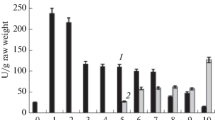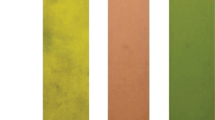Summary
The isoenzymes of NAD-specific glutamic dehydrogenase (GDH) of Pisum sativum, separated by polyacrylamide gel electrophoresis, constitute two patterns, each of which covers seven individual isoenzymes. One pattern (GDH-I) is found in the cotyledons and young shoots. The second one (GDH-II) occurs together with at least some GDH-I isoenzymes in pea roots. In the shoots of older pea plants GDH-II isoenzymes become visible in addition to the GDH-I pattern.
Section of the cotyledons (but not of the roots) of young pea seedlings causes the formation of the complete GDH-II isoenzyme pattern in the shoots within a few hours. It has been verified that the cotyledons specifically suppress the formation of the GDH-II pattern in the young shoot. In older plants which no longer depend on the cotyledons this effect is maintained somewhat less obviously by the root system.
In experiments with isolated shoot segments or shoot tips it has been shown that NH +4 reinforces the formation of the GDH-II whereas glucose shows the opposite effect.
The formation of the GDH-II isoenzymes in the presence of NH +4 is accompanied by an increase of the specific activity of GDH. Simultaneously the ratio of aminating activity (anabolic reaction) to deaminating activity (catabolic reaction) changes in favor of the anabolic reaction.
The results support the supposition that the GDH-I and GDH-II isoenzyme patterns correspond to different molecular forms of one enzyme, the GDH-II representing a form with predominantly anabolic function and the GDH-I a form which has merely metabolic or catabolic function.
Similar content being viewed by others
Literatur
Beevers, L., Hageman, R. H.: Nitrate reduction in higher plants. Ann. Rev. Plant Physiol. 20, 495–522 (1969).
Hartmann, T., Nagel, M., Ilert, H.-I.: Organspezifische multiple Formen der Glutamatdehydrogenase in Medicago sativa. Planta (Berl.) 111, 119–128 (1973).
Oghoghorie, C. G. O., Pate, J. S.: Exploration of the nitrogen transport system of a nodulated legume using 15N. Planta (Berl.) 104, 35–49 (1972).
Pahlich, E.: Sind die multiplen Formen der Glutamatdehydrogenase aus Erbsenkeimlingen Conformer? Planta (Berl.) 104, 78–88 (1972).
Pahlich, E., Jäger, H.-J., Steubing, L.: Beeinflussung der Aktivitäten von Glutamatdehydrogenase und Glutaminsynthetase aus Erbsenkeimlingen durch SO2. Angew. Bot. 46 183–197 (1972).
Wallace, W., Pate, J. S.: Nitrate reductase in the field pea (Pisum arvense L.). Ann. Botany 29, 655–671 (1965).
Wallace, W., Pate, J. S.: Nitrate assimilation in higher plants with special reference to the cocklebur (Xanthium pennsysvanicum Wallr.). Ann. Botany 31, 213–228 (1967).
Author information
Authors and Affiliations
Rights and permissions
About this article
Cite this article
Hartmann, T. Endogen und exogen ausgelöste Änderung des Isoenzymspektrums der NAD-spezifischen Glutamatdehydrogenase im Sproß von Pisum sativum . Planta 111, 129–136 (1973). https://doi.org/10.1007/BF00386273
Received:
Issue Date:
DOI: https://doi.org/10.1007/BF00386273




